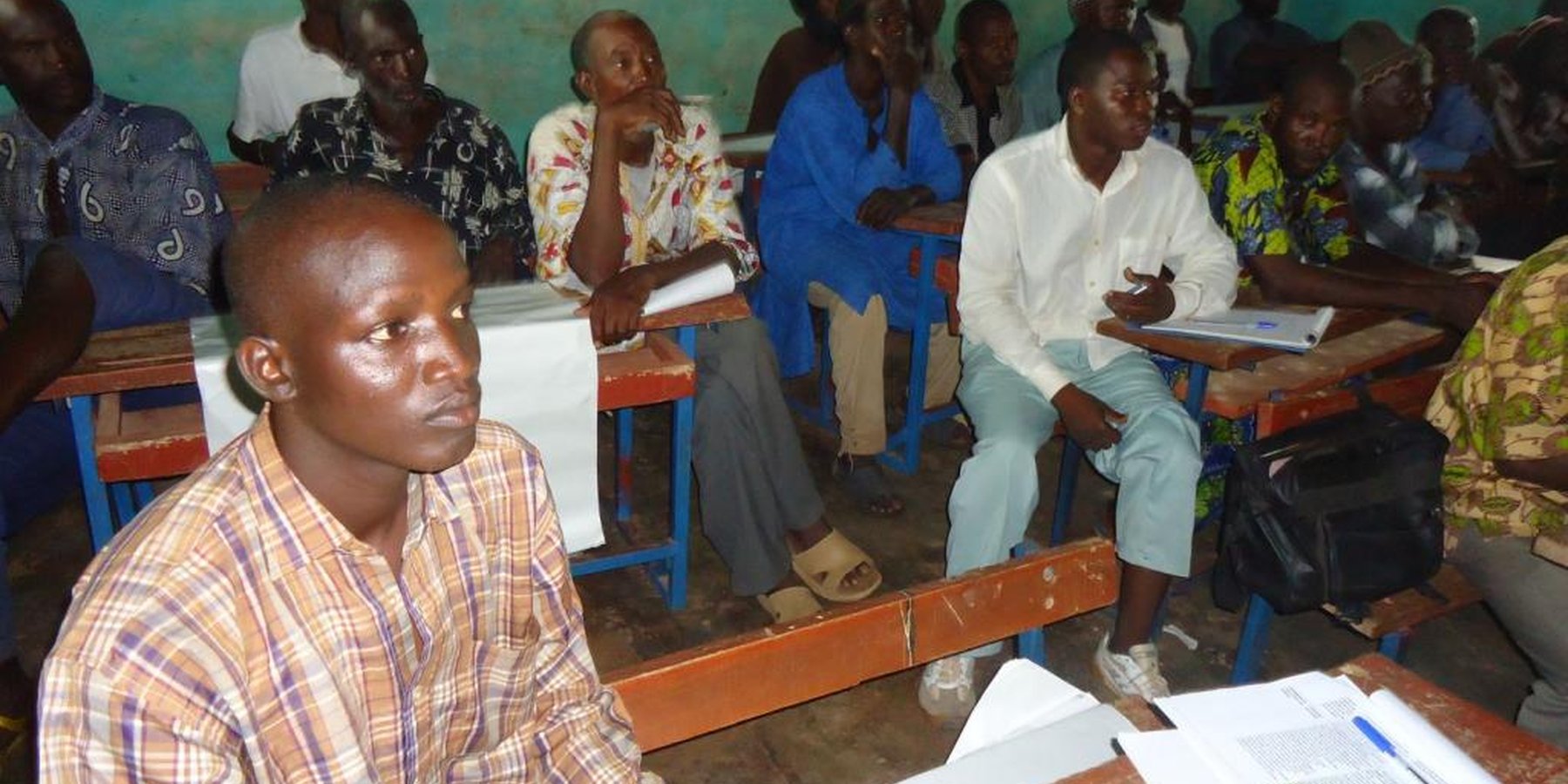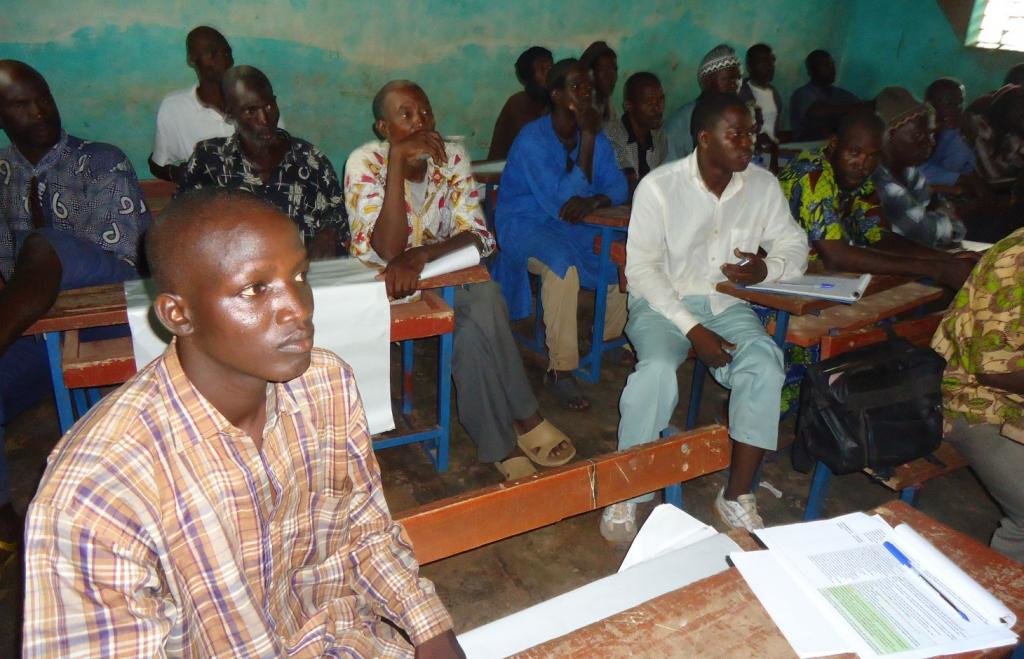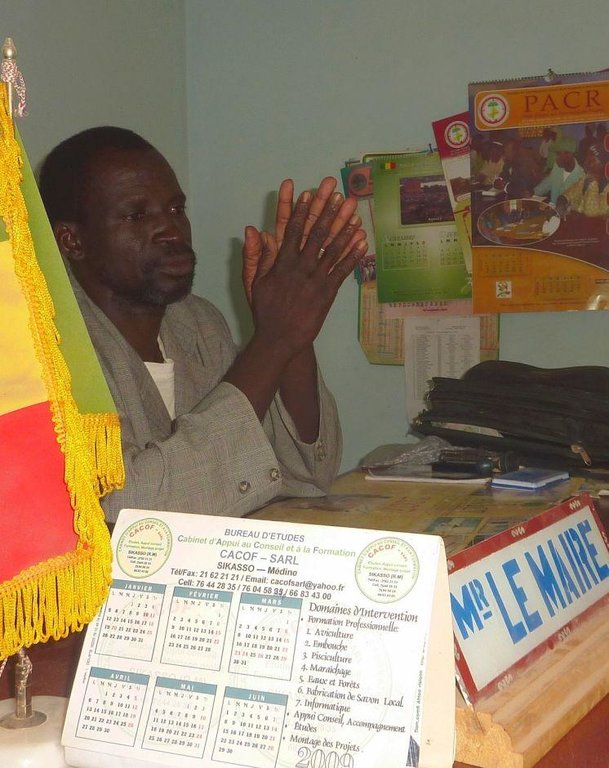Identifying and prioritizing scheme sites using a territorial, multi-stakeholder approach [Mali]
- Criação:
- Atualização:
- Compilador/a: Dieter Nill
- Editor: –
- Revisor: Laura Ebneter
Identification et priorisation des sites d’aménagement dans une approche territoriale multi-acteurs (French)
approaches_2499 - Mali
Veja as seções
Expandir tudo Recolher tudo1. Informação geral
1.2 Detalhes do contato das pessoas capacitadas e instituições envolvidas na avaliação e documentação da abordagem
Especialista em GST:
Diallo Safiatou
safiatou.diallo@helvetas.org
Helvetas - Swiss Intercooperation
Mali
Nome da(s) instituição(ões) que facilitou(ram) a documentação/avaliação da Abordagem (se relevante)
HELVETAS (Swiss Intercooperation)Nome da(s) instituição(ões) que facilitou(ram) a documentação/avaliação da Abordagem (se relevante)
Deutsche Gesellschaft für Internationale Zusammenarbeit (GIZ) GmbH (GIZ) - Alemanha1.3 Condições em relação ao uso da informação documentada através de WOCAT
Quando os dados foram compilados (no campo)?
01/07/2012
O/a compilador/a e a(s) pessoa(s) capacitada(s) aceitam as condições relativas ao uso de dados documentados através da WOCAT:
Sim
2. Descrição da abordagem de GST
2.1 Descrição curta da abordagem
The desired objectives are to identify the priority actions for investment that have been agreed by local actors within the framework of the pastoral scheme, and to develop lowland areas.
2.2 Descrição detalhada da abordagem
Descrição detalhada da abordagem:
The approach aims (i) to ensure that all actors involved in developing lowland areas participate in the planning process and (ii) to prepare the ground for the self-management of the lowland scheme from the outset of the process. The goal is to gear the identification and prioritisation processes for schemes being carried out by local authorities (regional council, intermunicipal body, circle) towards the actual needs of local people.
This is achieved by preparing actors and organising multi-stakeholder meetings so that the visions of the different parties can be aligned in an inclusive way. This joint approach ensures investments are more relevant and well founded.
This practice was implemented in the four circles participating the AVAL programme: Kadiolo,
Sikasso, Yorosso and Koutiala. The practice led to the identification of around 10 priority investment sites in each of the four circles concerned. The sites are agricultural (dams, ponds) or pastoral (rangeland, cattle market, route marking). At the beginning of the process, the terms of reference (ToR) and data collection sheets are drawn up and presented to all the actors to ensure they are equally informed and to demonstrate the relevance of the approach across the regional council. The first workshop promotes a common understanding of the objectives and outcomes of the good practice.
Data on actual investment needs is collected by the commune (using data collection sheets) from actors in each village. An initial proposal for the identification and prioritisation criteria for scheme sites is put together by the regional council and its staff. The criteria are submitted for the approval of local actors in forums organised at the circle level with the support of the technical services. Following a first sift based on predefined criteria, the select committee judges the commitments and budgets of each and allocates scores for each criteria ranging from zero to five. Compulsory criteria (initial selection stage): 1)Absence of land ownership disputes, 2)Membership of PDESC, 3)Opening up the area – distance to a road or track that is accessible in all seasons, 4)The number of beneficiaries, 5)Farming of lowland areas–area of farmed land in relation to the possible farmable area. Optional criteria (second-stage sift for projects that have cleared the initial stage): 1)Diversification–number of products or farms, 2)Gender–number of women in relation to men, 3)Capacity of actors to contribute. On this basis, the actors from each circle identify the sites that offer the greatest potential from among the development projects undertaken by communes in the area in the context of their development programmes. Local authorities are then tasked with ensuring the supervision of the development process and the management of works and developed land. At the prioritisation workshop, each commune in the circle takes turn presenting and making the case for its completed data sheet to the plenary.
The regional council initiates the process, defines the identification and prioritisation criteria, undertakes the regional consolidation of projects for delivery at the local level and acts as mediator between communities.
The circle councils organise the information and consultation workshops and the decision-making/prioritisation workshop, and they set up the moderation team with the support of technical services.
Communes pre-select projects at the commune level, assessing them in terms of their relevance to PDESC and the criteria put forward; they ensure data collection sheets are completed in collaboration with beneficiaries, and they take part in the prioritisation process by making the case for their projects.
The support structure (AVAL) provides training and advisory support to actors.
Technical services provide technical support and make sure activities are coherent and in line with national programmes. Consultants facilitate the process and train the actors.
2.3 Fotos da abordagem
2.5 País/região/locais onde a abordagem foi aplicada
País:
Mali
Região/Estado/Província:
Mali
Especificação adicional de localização:
Kadiolo, Sikasso, Yorosso, Koutiala
2.6 Datas de início e término da abordagem
Indique o ano de início:
2009
2.7 Tipo de abordagem
- Baseado em projeto/programa
2.8 Principais metas/objetivos da abordagem
The Approach focused mainly on SLM with other activities
The approach aims (i) to ensure that all actors involved in developing lowland areas participate in the planning process and (ii) to prepare the ground for the self-management of the lowland scheme from the outset of the process. The goal is to gear the identification and prioritisation processes for schemes being carried out by local authorities (regional council, intermunicipal body, circle) towards the actual needs of local people.
The SLM Approach addressed the following problems: lack of involvement of stakeholders in developing lowland areas
2.9 Condição que propiciam ou inibem a implementação de tecnologia/tecnologias aplicada(s) segundo a abordagem
Quadro institucional
- Inibitivo
lack of involvement of stakeholders in developing lowland areas
Treatment through the SLM Approach: all actors involved in developing lowland areas participate in the planning process
3. Participação e papel das partes interessadas envolvidas
3.1 Partes interessadas envolvidas na abordagem e seus papéis
- Usuários de terra/comunidades locais
- Especialistas em GST/ consultor agrícola
- Organização não governamental
HELVETAS - Swiss Intercooperation
- Governo nacional (planejadores, responsáveis pelas decisões)
3.2 Envolvimento do usuários de terra/comunidades locais nas diferentes fases da abordagem
| Envolvimento do usuários de terra/comunidades locais | Especifique quem estava envolvido e descreva as atividades | |
|---|---|---|
| Iniciação/motivação | Passivo | |
| Planejamento | Participativo | |
| Implementação | Participativo | |
| Monitoramento/avaliação | Passivo | |
| Research | Passivo |
3.4 Decisão sobre a seleção de tecnologia/tecnologias de GST
Especifique quem decidiu sobre a seleção de tecnologia/tecnologias a serem implementadas:
- Principalmente especialistas em GST, após consulta com usuários da terra
Explique:
Decisions on the method of implementing the SLM Technology were made by mainly by SLM specialists with consultation of land users
4. Suporte técnico, reforço das capacidades e gestão do conhecimento
4.1 Reforço das capacidades/ formação
Foi oferecida formação aos usuários da terra/outras partes interessadas?
Sim
Especifique quem foi capacitado:
- Usuários de terra
Tipo de formação:
- Reuniões públicas
4.2 Serviço de consultoria
Os usuários de terra têm acesso a um serviço de consultoria?
Sim
Especifique se foi oferecido serviço de consultoria:
- Em centros permanentes
Descreva/comentários:
Advisory service is quite adequate to ensure the continuation of land conservation activities; The planning capacity of local authorities is strengthened, and this expertise in the planning process can be applied to other sectors
4.3 Fortalecimento da instituição (desenvolvimento organizacional)
As instituições foram fortalecidas ou estabelecidas através da abordagem?
- Sim, significativamente
Especifique a que nível (níveis) as instituições foram fortalecidas ou estabelecidas:
- Local
Especifique o tipo de apoio:
- Reforço das capacidades/ formação
4.4 Monitoramento e avaliação
Monitoramento e avaliação são partes da abordagem?
Sim
Comentários:
socio-cultural aspects were ad hoc monitored by project staff through observations;
economic / production aspects were ad hoc monitored by project staff through observations
management of Approach aspects were ad hoc monitored by project staff through observations
There were no changes in the Approach as a result of monitoring and evaluation
There were no changes in the Technology as a result of monitoring and evaluation
4.5 Pesquisa
A pesquisa foi parte da abordagem?
Sim
Especifique os tópicos:
- Sociologia
- Economia/Marketing
- Tecnologia
5. Financiamento e apoio material externo
5.1 Orçamento anual para o componente de GST da abordagem
Caso o orçamento exato seja desconhecido, indique a faixa:
- 2.000-10.000
Comentários (p. ex. principais fontes de recursos/principais doadores):
Approach costs were met by the following donors: international non-government: 100.0%
5.2 Apoio financeiro/material concedido aos usuários da terra
Os usuários da terra receberam apoio financeiro/material para a implementação de tecnologia/tecnologias?
Não
5.3 Subsídios para entradas específicas (incluindo mão-de-obra)
- Nenhum
Se a mão-de-obra pelos usuários da terra foi uma entrada substancial, isso foi:
- Voluntário
5.4 Crédito
Foi concedido crédito segundo a abordagem para atividades de GST?
Não
6. Análise de impactos e declarações finais
6.1 Impactos da abordagem
A abordagem auxiliou os usuários da terra a implementar e manter as tecnologias de GST?
- Não
- Sim, pouco
- Sim, moderadamente
- Sim, significativamente
The planning capacity of local authorities is strengthened, and this expertise in the planning process can be applied to other sectors. Strong levels of community engagement are seen to arise. Investment decisions and funding awards are not carried out in secret deliberations or project offices. The links between the different levels in local authorities are reinforced and a shared development vision is jointly owned by all actors.
A abordagem concedeu autonomia aos grupos social e economicamente desfavorecidos?
- Não
- Sim, pouco
- Sim, moderadamente
- Sim, significativamente
Did other land users / projects adopt the Approach?
- Não
- Sim, pouco
- Sim, moderadamente
- Sim, significativamente
This practice was implemented in the four circles participating the AVAL programme: Kadiolo, Sikasso, Yorosso and Koutiala. The practice led to the identification of around 10 priority investment sites in each of the four circles concerned. The sites are agricultural (dams, ponds) or pastoral (rangeland, cattle market, route marking).
Did the Approach lead to improved livelihoods / human well-being?
- Não
- Sim, pouco
- Sim, moderadamente
- Sim, significativamente
Did the Approach help to alleviate poverty?
- Não
- Sim, pouco
- Sim, moderadamente
- Sim, significativamente
6.2 Principal motivação dos usuários da terra para implementar a GST
- Produção aumentada
- Lucro (lucrabilidade) aumentado, melhora da relação custo-benefício
- improvement of well-being and livelihoods
6.3 Atividades de sustentabilidade de abordagem
Os usuários da terra podem manter o que foi implementado através da abordagem (sem apoio externo)?
- Sim
6.4 Pontos fortes/vantagens da abordagem
| Pontos fortes/vantagens/oportunidades na visão do/a compilador/a ou de outra pessoa capacitada |
|---|
| The links between the different levels in local authorities are reinforced and a shared development vision is jointly owned by all actors. Each actor comes to understand their importance as part of the implementation of the investment programme. Moreover, strong levels of community engagement are seen to arise. Investment decisions and funding awards are not carried out in secret deliberations or project offices. |
| The moderate costs also help towards making this practice sustainable. |
|
The planning capacity of local authorities is strengthened, and this expertise in the planning process can be applied to other sectors. The inclusive approach and the local availability of facilitation skills are factors that make the practice sustainable. When outcomes are accepted by all actors, the uptake and sustainability of the practice become more likely. (How to sustain/ enhance this strength: It is essential to prepare thoroughly before beginning work: criteria must be clear and relevant; communes must describe and document their scheme propositions and back them up with appropriate arguments; and moderation teams must be objective. Ensuring actors are informed is a major factor for success: all parties have the right to timely information. Elected representatives must have a good understanding of their roles within the context of decentralisation and rural sector development; communities must be closely involved in the process. Inclusive participation requires the involvement of actors across the board. ) |
6.5 Pontos fracos, desvantagens da tecnologia e formas de superá-los
| Pontos fracos/vantagens/riscos na visão do/a compilador/a ou de outra pessoa capacitada | Como eles podem ser superados? |
|---|---|
| A major constraint in delivering this practice is the requirement that territorial communities contribute their own funds, as this forms part of the selection criteria |
7. Referências e links
7.1 Métodos/fontes de informação
- visitas de campo, pesquisas de campo
- entrevistas com usuários de terras
7.2 Referências às publicações disponíveis
Título, autor, ano, ISBN:
Manual of Good Practices in Small Scale Irrigation in the Sahel. Experiences from Mali. Published by GIZ in 2014.
Disponível de onde? Custos?
http://star-www.giz.de/starweb/giz/pub/servlet.starweb
Título, autor, ano, ISBN:
HELVETAS Swiss Intercooperation (2009), Rapport du forum de priorisation des investissements hydro-agricoles et pastoraux. [Report of the hydro-agricultural and pastoral investment prioritisation forum]
Título, autor, ano, ISBN:
HELVETAS Swiss Intercooperation (2010), Convention du partenariat local des cercles de Kadiolo, Sikasso, Koutiala, Yorosso. [Local partnership agreement between the Kadiolo, Sikasso, Koutiala and Yorosso circles]
Links e módulos
Expandir tudo Recolher tudoLinks
Não há links
Módulos
Não há módulos




